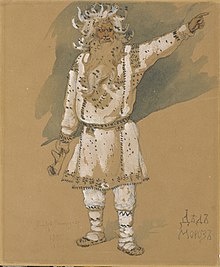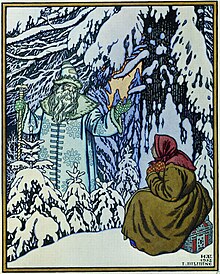Jack Frost


Father Frost (including Russian Дед Мороз Djed Moros or Морозко Morozko, "grandfather Frost", also Djeduschka Moros "grandfather Frost", but also in non-Slavic languages, e.g. Lithuanian Senis Šaltis , Estonian Näärivana ) is originally similar to Santa Claus Russian fairy tale character that comes from Slavic mythology and embodies the personification of winter. Father Frost gives presents to the children on New Year's Eve. He is accompanied by his granddaughter Snegurochka ( Snow Maiden or Snow Maiden ). This custom is also widespread in other Eastern European countries.
Emergence
The roots of the character of Djed Moros or Father Frost lie in Slavic mythology. Originally the figure was called Morosko as a winter wizard or spirit . The figure has been traceable in (fairy tale) literature for centuries and gained widespread use and great popularity, especially in the second half of the 19th century, in and outside Russia.
In the first years after the October Revolution, Djed Moroz was denigrated as a personification of winter and as part of Russian Christmas traditions, like all other Christmas figures, including Snegurochka and Jolka (Ёлка - Christmas tree).
The figure of Father Frost and the artificially created "Jolkafest" (on Gregorian New Year's Eve) became so successful in Russia that most Russians hold on to it even after the holiday was reinstated for Orthodox Christmas. In the meantime, Father Frost even has an "official" Christmas post office in Veliky Ustyug , where you can write to him and get an answer.
Father Frost also played a major role in other Slavic countries, especially during socialism and communism , but was already known there before. For example, the figure is called Deda Mraz in Serbia , Děda Mráz in the Czech Republic and Dedek Mraz in Slovenia . However, the figure was largely rejected as a (supposedly) artificially imported Christmas substitute from the Soviet Union and is no longer common today. Only in Slovenia (Dedek Mraz) and Bulgaria has this been preserved. There it is also called Дядо мраз (Djado Mraz).
concept
Since the Christian religion has been suppressed since the Russian October Revolution and it was forbidden to celebrate Christmas as a religious festival and at the same time the Gregorian calendar was introduced instead of the Julian calendar , all festive Christmas rituals were postponed from Christmas according to the Julian calendar to New Year's Eve Gregorian calendar. Presumably, therefore, the Jolkafest is associated with Gregorian New Year's Eve and Djed Moros , who brings the presents on Gregorian New Year's Eve, is associated with Christmas.
According to popular belief today, Father Frost has a long, thick white beard and wields a magical scepter , the tip of which freezes everything she touches. He lives deep in the taiga , is very close to nature, drives a sleigh pulled by three white horses or reindeer - the troika - and traditionally wears an ice-gray fur coat interwoven with shades of blue , but these can also be yellow or green. Under Western influence, however, depictions in red cloaks can also be found today.
Processing
- Adventure in the Magic Forest (1964), Russian fairy tale film
- Frostfeuer (2005), a fantasy novel by the German author Kai Meyer , is set in northern Russia. Father Frost appears in the introduction.
- The Guardians of Light (2012), American animated film by DreamWorks Animation .
See also
Web links
- Fairy tale of Father Frost (German translation)
- Геральдика Деда Мороза Heraldry of Father Frost
Individual evidence
- ^ Father Frost: Russian Fairy Tale & Folklore. Accessed December 18, 2018 .
- ^ Tibi Puiu: Ded Moroz: the story of the soviet Santa Claus. In: ZME Science. December 20, 2016. Retrieved December 18, 2018 (American English).
- ↑ Potschta Deda Morosa. In: pochta-dm.ru. Retrieved July 23, 2014 (Russian).
